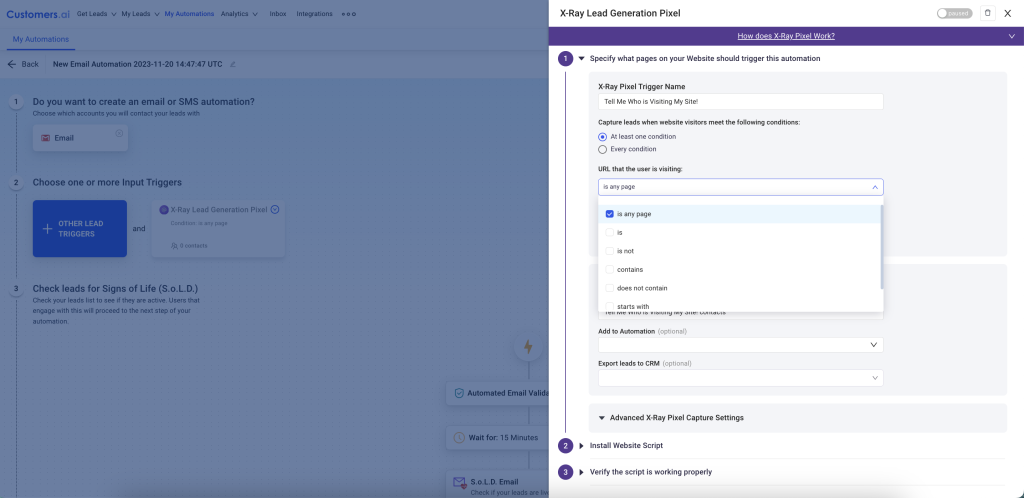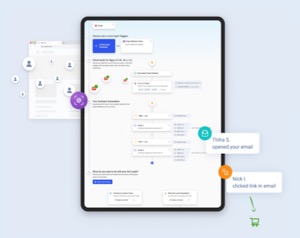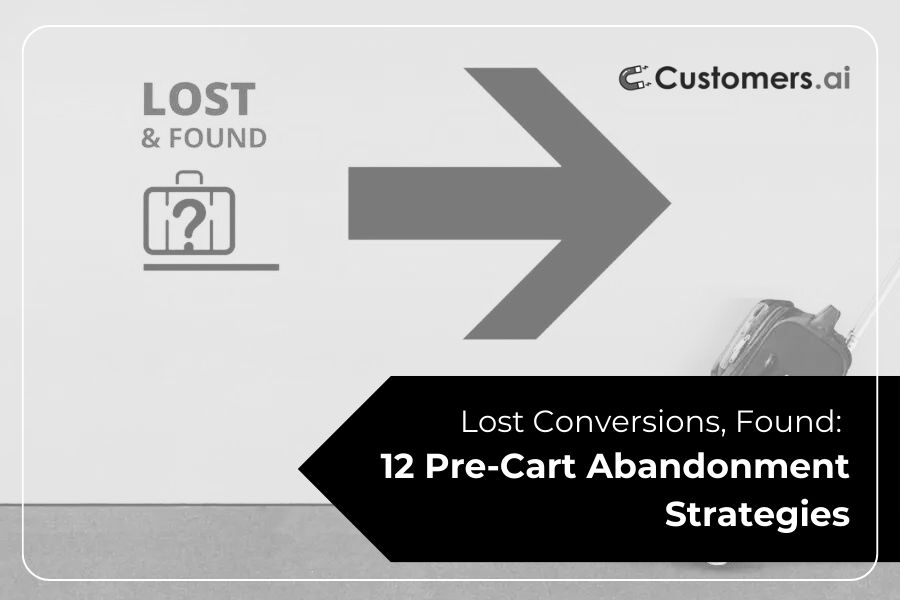With 97% of potential customers exiting a website before reaching the shopping cart, understanding pre-cart abandonment is essential.
These visitors represent a huge opportunity – and a huge missed opportunity! After all, these people are familiar with your brand, interested in your business, and interested in buying what you have to sell. You have to figure out how to capture their information and how to get them into the funnel.

That’s where pre-cart abandonment strategies come in. But we have to go beyond the usual best practices. Yes, we know that factors like slow websites and poor design lead to abandonment. That’s not enough. We need to make the extra effort to minimize abandonment and optimize the overall conversion funnel.
Let’s explore 12 pre-cart abandonment strategies to address these challenges and guide potential customers back into the sales journey.
- Website Visitor Identification
- Targeted Remarketing Campaigns
- Exit-Intent Popups
- Email Capture Strategies
- Personalized Product Recommendations
- Optimized Call-to-Action (CTA) Buttons
- User-Friendly Navigation
- Data Analysis for Personalization
- Limited-Time Promotions
- Live Chat Support
- Clear Shipping and Return Information
- Social Proof and Trust Badges
Convert Website Visitors into Real Contacts!
Identify who is visiting your site with name, email and more. Get 500 contacts for free!
1. Website Visitor Identification
We’ve talked a lot about website visitor identification lately, and we are going to continue talking about it. Being able to identify who is on your website – names, emails, companies, phone numbers, etc – is a secret weapon for any online business.
It’s also unbelievably easy to do. With the Customers.ai Website Visitor ID X-Ray Pixel, you can start identifying anonymous visitors in 90 seconds. Here’s how:
Step 1: To install the Website Visitor ID X-Ray Pixel, sign up (for FREE!), go to your dashboard, and navigate to My Automations.
Step 2: Select + New Automation and get your pixel. We have easy install options for Google Tag Manager, WordPress, and Shopify, or you can install the pixel manually.

From there, you can build email campaigns, remarketing campaigns, sales outreach strategies, and so much more.
2. Targeted Remarketing Campaigns
Targeted remarketing campaigns are the perfect way to re-engage visitors who left but have displayed interest in your products.
Retargeting ads let you delicately remind them of the products they explored and by leveraging personalized ad creative, you can speak directly to their preferences.
The key to engaging these people lies in the content itself. You must create compelling content that serves as a persuasive nudge and encourages them to return and finalize their purchase.
Unfortunately for marketers, retargeting audiences are shrinking, and first-party data ownership has become imperative.
Sophisticated tools like the Customers.ai Website Visitor ID X-Ray pixel mentioned above, allow you to capture that first-party data and build sizable and precisely targeted remarketing lists.
3. Exit-Intent Popups
Strategically timed to appear as visitors show signs of leaving, exit-intent popups present a golden opportunity to capture crucial information.
By offering exclusive deals, enticing discounts, or valuable content, you can incentivize users to share their email addresses, laying the foundation for a robust subscriber list.

Exit-intent popups are a proactive approach that not only help retain those looking to jump ship, but also open avenues for sustained engagement and targeted marketing efforts. Turn exits into entrances for future conversions. However, it’s crucial to acknowledge and address e-commerce challenges such as cart abandonment and consumer trust in order to optimize the effectiveness of exit-intent popups.
4. Email Capture Strategies
The key to an effective pre-cart email capture strategy is to go beyond the conventional.
Craft compelling lead magnets—be it newsletters, exclusive offers, or downloadable resources—that entice visitors to share their email addresses willingly. Strategically placed opt-in forms on pre-cart pages serve as the gateway to building a robust subscriber list.
By creating engaging and unobtrusive opportunities for subscription, you not only capture valuable contact information but also pave the way for establishing a direct line of communication with potential customers.
5. Personalized Product Recommendations
Personalized product recommendations are a must for any pre-cart abandonment strategy.
Implementing advanced algorithms that scrutinize user behavior enable you to offer tailor-made suggestions. By showcasing these particular recommendations on pre-cart pages—crafted based on individual browsing history and preferences—you enhance user engagement and significantly boost the likelihood of a conversion.

Here’s the thing. The power of personalization lies in its ability to resonate with individiuals. Just like email capture strategies and remarketing campaigns require data and creativity, so does your personalization strategy.
The journey from visitor to customer often hinges on the effectiveness of your Call-to-Action (CTA) buttons.
Design clear and compelling CTAs that seamlessly direct visitors through the conversion funnel.
Here is an example of a CTA we use to promote our webinar, Beyond Abandoned Cart to Abandoned Product View Revenue:
Ecommerce Webinar

Beyond Abandoned Cart to Abandoned Product View Revenue
with Email Deliverability Hacks & AI Tools
To refine and amplify their impact, use A/B testing methodologies to experiment with different CTA variations. A/B testing allows you to pinpoint the most effective elements, ensuring your CTAs not only capture attention but also prompt decisive action.
By optimizing your CTA buttons, you help visitors take the next step in the buyer journey, ultimately enhancing the overall conversion rate of your pre-cart abandonment strategy.
The first impression often begins with navigation, making it a pivotal aspect of your pre-cart strategy.
You must optimize your website’s navigation to guarantee a seamless and user-friendly experience for every visitor.
- Streamline menus and eliminate unnecessary complexities
- Offer clear and intuitive pathways that guide users to their desired products
- Reduce friction in the navigation process
A user-friendly interface not only enhances the overall browsing experience but also sets the stage for increased engagement and conversions in the pre-cart phase.
8. Data Analysis for Personalization
Data, data, data. You must use the data you have at your disposal to gain insights into visitor behavior and preferences and form a comprehensive understanding of their unique journeys.
This valuable data serves as the foundation for a personalized user experience, allowing you to tailor pre-cart pages with precision. From curated product offerings to the personalized recommendations we mentioned above, using data analysis enhances the relevance of your content, making each interaction more meaningful for the visitor.
9. Limited-Time Promotions
Inject a sense of urgency into your pre-cart abandonment strategy with the strategic use of limited-time promotions.
By offering exclusive discounts or time-sensitive deals, you create an atmosphere that encourages immediate action from potential customers.
The trick here is to display these promotions on pre-cart pages, ensuring that visitors can’t overlook the offers. This tactic not only captures attention but also taps into the psychology of urgency, prompting users to make quicker decisions and move closer to completing their purchase.

Limited-time promotions can help drive immediate conversions and instill a sense of excitement and anticipation.
10. Live Chat Support
Offering real-time assistance to visitors ensures that their questions and concerns are addressed promptly, reducing the likelihood of abandonment.
Beyond immediate support, live chat can give you some really valuable data. Use those live chat interactions to see what customers care about. What are they asking? What are their concerns?
This data becomes a powerful tool, enabling you to tailor personalized recommendations based on the specific needs and preferences expressed during chat sessions.
Live chat support lets you enhance customer satisfaction and create a dynamic and interactive environment that fosters trust and loyalty.
11. Clear Shipping and Return Information
Build trust and alleviate customer concerns by prioritizing transparent communication about shipping and return policies on your pre-cart pages.
Make sure information regarding shipping costs and return procedures is easily accessible. It can help eliminate any uncertainties potential customers may have and prevent cart abandonment.

By addressing these concerns proactively, you create a sense of reliability and openness, reinforcing the trustworthiness of your brand. Clear and upfront communication fosters a positive perception and streamlines the decision-making process for visitors. The result? An increased likelihood of conversions in the pre-cart phase.
92% of consumers trust recommendations from friends and family more than all other forms of marketing. Why? Because they trust those people, therefore they trust your business.
Establishing trust is paramount in the world of ecommerce, and leveraging social proof and trust badges is a potent strategy in your pre-cart approach.
Display customer testimonials and reviews directly on your pre-cart pages. It builds credibility and instills confidence in potential buyers. Additionally, incorporate trust badges and security certifications visibly, assuring visitors of the safety and reliability of their transactions.
By highlighting positive experiences and emphasizing security measures, you create an environment customers feel comfortable in, leading to higher conversions in the critical pre-cart phase.
Convert Website Visitors into Real Contacts!
Identify who is visiting your site with name, email and more. Get 500 contacts for free!
Preparing Your Pre-Cart Abandonment Strategy
Mastering pre-cart abandonment is the key to unlocking untapped sales opportunities.
By embracing innovative strategies such as website visitor identification, targeted remarketing campaigns, personalized product recommendations, and more, businesses can not only recapture the attention of departing visitors but also guide them toward completing their purchases.
Plus, as cookie tracking continues to go away and tech companies make it harder and harder to market to individuals, implementing these comprehensive pre-cart strategies becomes essential for not just retaining potential customers but also ensuring a dynamic and engaging online shopping experience.
One of the easiest ways to start is with Customers.ai. Download the Website Visitor ID X-Ray pixel for free and start capturing these pre-cart visitors.

See Who Is On Your Site Right Now!
Turn anonymous visitors into genuine contacts.
Try it Free, No Credit Card Required
Important Next Steps
- See what targeted outbound marketing is all about. Capture and engage your first 500 website visitor leads with Customers.ai X-Ray website visitor identification for free.
- Talk and learn about sales outreach automation with other growth enthusiasts. Join Customers.ai Island, our Facebook group of 40K marketers and entrepreneurs who are ready to support you.
- Advance your marketing performance with Sales Outreach School, a free tutorial and training area for sales pros and marketers.
Pre-Cart Abandonment FAQs
Q: What is pre-cart abandonment in e-commerce?
Pre-cart abandonment refers to users leaving a website before adding items to their shopping cart, indicating a lost potential sale.
Q: How to track pre-cart abandonment on an e-commerce site?
Use analytics tools to monitor user behavior, focusing on page exits before the checkout process.
Q: Why do customers abandon their carts before adding items?
Common reasons include high shipping costs, complicated checkout processes, and unexpected fees.
Q: What are effective strategies to reduce pre-cart abandonment?
Streamline the checkout process, offer transparent pricing, and provide personalized recommendations.
Q: Can exit-intent pop-ups help prevent pre-cart abandonment?
Yes, strategically implemented exit-intent pop-ups can offer incentives or assistance, potentially retaining users.
Q: How does mobile optimization impact pre-cart abandonment?
Mobile optimization is crucial as more users shop on mobile devices, ensuring a seamless and user-friendly experience.
Q: Are discounts effective in preventing pre-cart abandonment?
Discounts can be effective if strategically used to address specific concerns that lead to abandonment.
Q: What role does real-time customer support play in preventing pre-cart abandonment?
Real-time support, like live chat, can address customer concerns immediately, potentially saving a sale.
Q: How does website loading speed affect pre-cart abandonment?
Slow loading times can frustrate users and lead to abandonment; optimize your site for better performance.
Q: Is offering a guest checkout option effective in reducing pre-cart abandonment?
Yes, providing a guest checkout option simplifies the process, reducing barriers for users who don’t want to create an account.
Q: Can retargeting ads help recover potential pre-cart abandoners?
Yes, retargeting ads remind users of their abandoned items and offer incentives to encourage them to return and complete the purchase.
Q: How can email marketing address pre-cart abandonment?
Email campaigns can send personalized reminders, incentives, and re-engage users who abandoned their carts.
Q: Is conducting surveys effective in understanding reasons for pre-cart abandonment?
Yes, surveys provide valuable insights into reasons for abandonment, helping you make targeted improvements.
Q: How can social proof be used to reduce pre-cart abandonment?
Displaying social proof, like customer testimonials, builds trust and alleviates concerns that lead to abandonment.
Q: What impact does a clear return policy have on pre-cart abandonment?
A transparent return policy reassures customers, addressing concerns about potential issues with purchased products.
Q: Is A/B testing recommended for optimizing the checkout process?
Yes, A/B testing allows you to experiment with different checkout elements, identifying and implementing improvements.
Q: How does transparency in pricing reduce pre-cart abandonment?
Transparent pricing builds trust, reducing the likelihood of users abandoning their carts due to unexpected costs.
Q: Why is personalization important in reducing pre-cart abandonment?
Personalization enhances the shopping experience, making users more likely to complete a purchase.
Q: What role do trust signals play in preventing pre-cart abandonment?
Trust signals, such as secure payment options and clear privacy policies, instill confidence and reduce abandonment.
Q: How does offering limited-time promotions impact pre-cart abandonment?
Limited-time promotions create a sense of urgency, motivating users to complete their purchases to avail of the offer.
Q: How can social media integration reduce pre-cart abandonment?
Social media integration allows users to share and discuss potential purchases, creating a sense of community and trust.
Q: What impact does a user-friendly product search have on pre-cart abandonment?
A user-friendly product search reduces frustration, helping users quickly find and add items to their carts.
Q: Why is simplicity in design crucial for preventing pre-cart abandonment?
Simple and intuitive design reduces cognitive load, making the shopping experience more enjoyable and reducing abandonment.
Q: How does addressing common objections in product descriptions impact pre-cart abandonment?
Addressing objections in product descriptions provides clarity, helping users make informed decisions and reducing abandonment.
Q: Can gamification elements be used to reduce pre-cart abandonment?
Yes, gamification elements, like progress bars or rewards for completing the checkout, can make the process more engaging, reducing abandonment.
